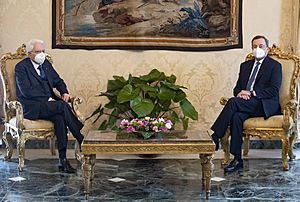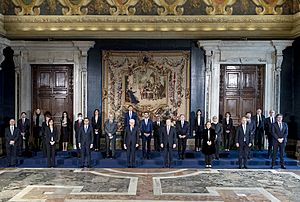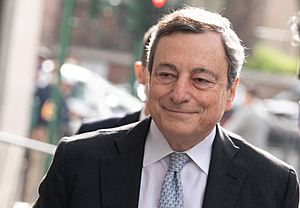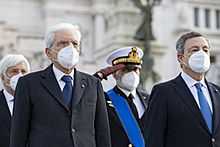Mario Draghi facts for kids
Quick facts for kids
Mario Draghi
|
|
|---|---|

Draghi in 2021
|
|
| Prime Minister of Italy | |
| In office 13 February 2021 – 22 October 2022 |
|
| President | Sergio Mattarella |
| Preceded by | Giuseppe Conte |
| Succeeded by | Giorgia Meloni |
| President of the European Central Bank | |
| In office 1 November 2011 – 31 October 2019 |
|
| Vice President | Vítor Constâncio Luis de Guindos |
| Preceded by | Jean-Claude Trichet |
| Succeeded by | Christine Lagarde |
| Chair of the Financial Stability Board | |
| In office 2 April 2006 – 4 November 2011 |
|
| Preceded by | Position established |
| Succeeded by | Mark Carney |
| Governor of the Bank of Italy | |
| In office 16 January 2006 – 31 October 2011 |
|
| Preceded by | Antonio Fazio |
| Succeeded by | Ignazio Visco |
| Personal details | |
| Born | 3 September 1947 Rome, Italy |
| Political party | Independent |
| Spouse |
Serena Cappello
(m. 1973) |
| Children | 2 |
| Education | Sapienza University of Rome (BEc, MSc) Massachusetts Institute of Technology (PhD) |
| Signature |  |
Mario Draghi (born 3 September 1947) is an important Italian figure. He has been a politician, an economist, and a banker. He served as the prime minister of Italy from February 2021 to October 2022.
Before becoming prime minister, he was the head of the European Central Bank (ECB). This bank is very important for countries that use the euro currency. He also led the Financial Stability Board and was the governor of the Bank of Italy.
Mario Draghi is known for his work during tough economic times. Many people call him "Super Mario" because he helped save the euro currency. He is seen as a very powerful and influential person in Europe.
Who is Mario Draghi?
Mario Draghi has had a long and impressive career. He started as a professor and then worked for the World Bank. Later, he became a top official in the Italian government. He also worked for a big investment bank called Goldman Sachs.
In 2006, he became the Governor of the Bank of Italy. This was during the time of the Great Recession. He then became the first head of the Financial Stability Board. This group helps keep the world's financial system stable.
Early Life and School
Mario Draghi was born in Rome, Italy, in 1947. His father worked for the Bank of Italy and other big companies. His mother was a pharmacist. Mario was the oldest of three children. Sadly, he lost both his parents when he was young.
He went to a Jesuit school in Rome. Later, he studied economics at the Sapienza University of Rome. He then earned a PhD in economics from the Massachusetts Institute of Technology (MIT) in the United States.
Working in Finance and Government
From 1975 to 1994, Draghi was a professor at several universities in Italy. During this time, he also worked for the World Bank in Washington, D.C.
In 1991, he became the Director General of the Italian Treasury. This was a very important job in the government. He helped change Italy's laws about companies and money. He also helped sell many state-owned companies to private owners.
In 2001, he left the Treasury to work at Harvard University. From 2002 to 2005, he was a vice chairman at Goldman Sachs International. He helped guide their work in Europe.
Helping the Bank of Italy
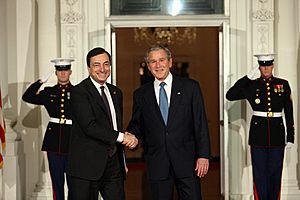
In 2006, Mario Draghi became the governor of the Bank of Italy. This is Italy's central bank. In this role, he also joined important groups like the European Central Bank and the Bank for International Settlements.
He also became the chairman of the Financial Stability Forum. This group later became the Financial Stability Board (FSB). The FSB works to make sure the world's financial markets are stable. Draghi was the first person to lead the FSB.
Leading the European Central Bank
In 2011, Mario Draghi was chosen to be the President of the European Central Bank (ECB). This is one of the most powerful economic jobs in the world. He took office on 1 November 2011.
He led the ECB during the Eurozone crisis. This was a time when some countries using the euro faced big money problems. Draghi famously said the ECB would do "whatever it takes" to save the euro. This statement helped calm financial markets and is seen as a key moment in saving the currency.
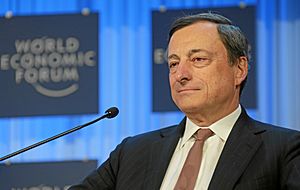
Because of his actions, Forbes magazine listed him as one of the most powerful people in the world. Fortune magazine called him the world's "second greatest leader." Many people credit him with saving the euro.
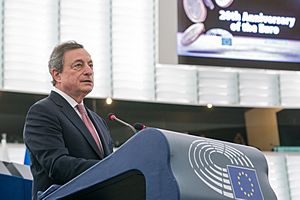
His term as ECB President ended on 31 October 2019. Christine Lagarde took over his role.
Becoming Prime Minister of Italy
In February 2021, Italy was facing a political crisis and the COVID-19 pandemic in Italy. President Sergio Mattarella asked Mario Draghi to form a new government. Draghi accepted the challenge.
He worked with many different political parties to create a "government of national unity." This meant parties from across the political spectrum joined his government. He was sworn in as prime minister on 13 February 2021.
His government quickly gained strong support in the Italian Parliament. Draghi promised to help Italy recover from the pandemic. He also stressed that Italy would remain strongly pro-European. He even decided not to take his annual salary as prime minister.
Handling the COVID-19 Pandemic
One of Draghi's main goals was to manage Italy's response to the COVID-19 pandemic. He reorganized the country's health and vaccination efforts. He also worked with the European Union to make sure vaccines produced in Italy were used for EU citizens first.
In March 2021, he authorized blocking a shipment of vaccines meant for Australia. This decision was praised by some European leaders. He also put most of Italy under a "full lockdown" to slow the virus spread. He promised to speed up Italy's vaccination program.
Later, his government introduced the "Green Pass." This digital certificate showed if someone was vaccinated or had a negative test. It was needed for many activities, like sports events, restaurants, and public transport. In October 2021, Italy became the first country to require this pass for all workers. In January 2022, vaccination became mandatory for Italians over 50.
Changes in Italy
Draghi's government also worked on important changes within Italy. They reformed the justice system to make legal cases faster. This was seen as a big step forward after many years.
His government also changed pension rules and the "citizens' income" program. The new budget included tax cuts, help for businesses, and support for people buying their first homes. At the end of 2021, The Economist magazine named Italy its "Country of the Year." They highlighted Draghi's leadership as a key reason.
Italy's Role in the World
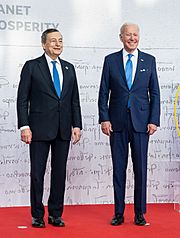
Draghi made Italy more active in international affairs. He visited Libya to strengthen ties with the African country. He also spoke strongly against Turkish President Recep Tayyip Erdoğan's behavior towards European leaders.
In June 2021, he attended his first G7 summit. He also met with U.S. President Joe Biden. In August 2021, Italy helped evacuate nearly 5,000 Afghans from Kabul.
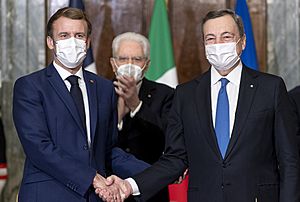
In October 2021, Rome hosted the G20 summit. Draghi and other world leaders discussed climate change and global recovery from the pandemic. In November 2021, Draghi signed the "Quirinal Treaty" with French President Emmanuel Macron. This treaty aims to improve cooperation between Italy and France.
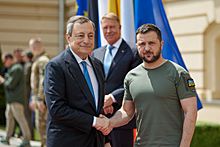
When Russia invaded Ukraine in February 2022, Draghi strongly condemned the attack. He supported sanctions against Russia and helped send military aid to Ukraine. He also supported Ukraine's application to join the European Union. In June 2022, Draghi visited Kyiv with the French and German leaders to meet with Ukrainian President Volodymyr Zelenskyy.
Resignation
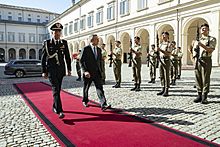
In July 2022, some political parties in Italy withdrew their support for Draghi's government. This led to a new political crisis. On 21 July, Mario Draghi officially resigned as prime minister. President Mattarella accepted his resignation. Draghi remained in office as a caretaker prime minister until a new government was formed after the general election. He was succeeded by Giorgia Meloni in October 2022.
After Being Prime Minister
From 2023 to 2024, Mario Draghi wrote a report on how Europe can be more competitive. In February 2025, he gave a speech in Brussels. He said that the European Union needs to work together "more and more as if we were one state." He talked about making energy markets better and encouraging new ideas. He also stressed the need to remove barriers within Europe to help businesses grow.
Personal Life
Mario Draghi married Maria Serenella Cappello in 1973. They have two children, Federica and Giacomo. Federica works in investments, and Giacomo is a finance analyst.
Draghi is a Catholic and went to a Jesuit school. He supports the A.S. Roma football team and loves basketball. He has homes in Rome and in Città della Pieve.
Awards and Recognition
Mario Draghi has received many awards and honors for his work.
- He has been given the highest honors in Italy, including the Order of Merit of the Italian Republic.
- He has also received honors from other countries, such as the Legion of Honour from France and the Order of Merit of the Federal Republic of Germany.
- In 2017, he received the Jean Monnet Foundation for Europe's Gold Medal.
- In 2022, he received the World Statesman Award from Henry Kissinger.
- In 2025, he was awarded the Princess of Asturias Award for International Cooperation.
He has also received many honorary degrees from universities around the world. These include degrees in business, statistics, political science, economics, and law.
See also
 In Spanish: Mario Draghi para niños
In Spanish: Mario Draghi para niños



